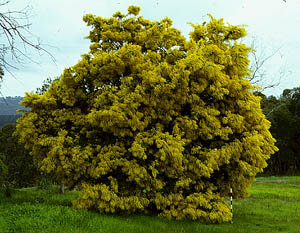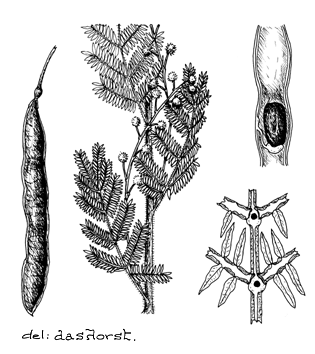Family: Fabaceae
Acacia baileyana

Citation:
F. Mueller, Trans. Proc. R. Soc. Vic. 24:168 (1888).
Derivation: baileyana--in honour of Frederic Manson Bailey (1827-1915), a Colonial Botanist in Qld. Synonymy: Racospermum baileyanum (F. Muell.)Pedley, Austrobaileya 2:345 (1987). , Racosperma baileyanum Common name: Cootamundra wattle
Description:
Shrubs or small trees to 6 m high with a silvery-blue foliage, at first conical with branches to the ground but later develops a short trunk with a rounded canopy; branchlets ridged and somewhat furrowed often pruinose more or less pubescent with short spreading hairs. Leaves bipinnate, glaucous; petiole short, 2-5 mm long; rachis 1-3 cm long, with a gland at the junction of usually only the top few pinnae pairs; pinnae 2-6 pairs, crowded; pinnules 12-20 pairs, linear-oblong, 5-7 mm long, 1-1.5 mm broad, flat, slightly curved usually glabrous but sometimes with a few marginal hairs. Inflorescences in axillary racemes or panicles longer than leaves; flower-heads globular, bright yellow 20-25-flowered; peduncles pruinose, glabrous, c. 6 mm long; flowers 5-merous. Legumes 4-10 cm long, 8-12 mm broad, straight or slightly curved, flattish, brown, pruinose or glaucous when young, margins almost straight or slightly irregularly constricted. Seeds longitudinal in legume; funicle short and filiform, aril small.
|
|
Distribution:
|
Introduced from the eastern States. Occurs mainly in the Northern and Southern Lofty regions around the Adelaide Hills areas as a garden escape. Soils; hard neutral yellow duplex and hard alkaline red duplex. Rainfall 700-1200 mm. A limited natural distribution in the Cootamundra and Wagga districts of N.S.W., also A.C.T. and Vic. (naturalised).
S.Aust.: NL, SL, KI, SE.
|
Flowering time: July — September. |

SA Distribution Map based
on current data relating to
specimens held in the
State Herbarium of South Australia
|
Biology:
No text
Taxonomic notes:
Acacia baileyana was not listed as being cultivated in the Adelaide Botanic Garden in 1859, 1871 and 1878 but a specimen dated 1895 is in the State Herbarium.The first adventive specimens were collected in 1943 near Mt Lofty by Professor J. B. Cleland. A. baileyana is now naturalised in New Zealand, Webb et al. (1988). For the result of seven pre-sowing treatments on germination see Aveyard (1968). A paper by Boden (1969) described some variation and the inheritance of flowering in A. baileyana. This species has been popular in cultivation for over a hundred years. Very large numbers are distributed by nurserymen. It is not long lived in cultivation and trees of A. baileyana in cultivation in the Waite Arboretum lived from 10 to 26 years with an average of 17 years for 6 trees. The species was originally restricted to an area within 48 km of Cootamundra, N.S.W. Professor Pryor in Canberra first noticed a group of early flowering trees in 1955. In 1960 these were re-examined and some late flowering trees were also detected. The flowering behaviour proved consistent over a number of years though seasonal variation in climate caused some differences from year to year. As a spread of flowering times would obviously be of horticultural interest some early flowering plants were vegetatively propagated and continued to flower early. Seedlings of both early and late flowering forms were tested, and about 86% of the progeny were true to the early flowering habit. In addition to these a purple-leafed, yellow-leafed, reddish new growth and prostrate form are now available. As they are generally grown from seed, some variation can be expected and more cultivars of Australian wattles will become available. Hall (1979) dealt with A. baileyana as No. 6 in a limited series on Australian Acacias. The geographical distribution, ecology, botanical features, utilisation and brief bibliography are provided. All parts of A. baileyana, preferably separately, can be used to dye wool. The colours may range from dark green, fawns, pale yellow, gold to orange depending on the mordants used, Martin (1974). Myers (1936) reports a germination test on seed of A. baileyana. Best results were obtained by putting seed into boiling water which was then allowed to cool. The only mistletoe recorded on A. baileyana in the State Herbarium is Amyema preissii, wire-leaved mistletoe which infests many Acacia species. A. baileyana is a food plant for the larvae of the butterfly Polyura pyrrhus, Fisher (1978). A. baileyana has become established in South Africa, Ross (1975). Detailed life history studies of A. baileyana were made by Newman 1934a, b, c, in which ecological, vegetative and reproductive phases were examined. There are many illustrations of cellular structure.
Cultivation:
A very attractive small tree with feathery blue foliage and golden yellow flowers. Widely planted as an ornamental, shade or shelter tree, not suitable for limestone areas but preferring cooler hills area with higher rainfall. A very fast growing but rather short-lived species.
Author:
Not yet available
References:
Source:

|

